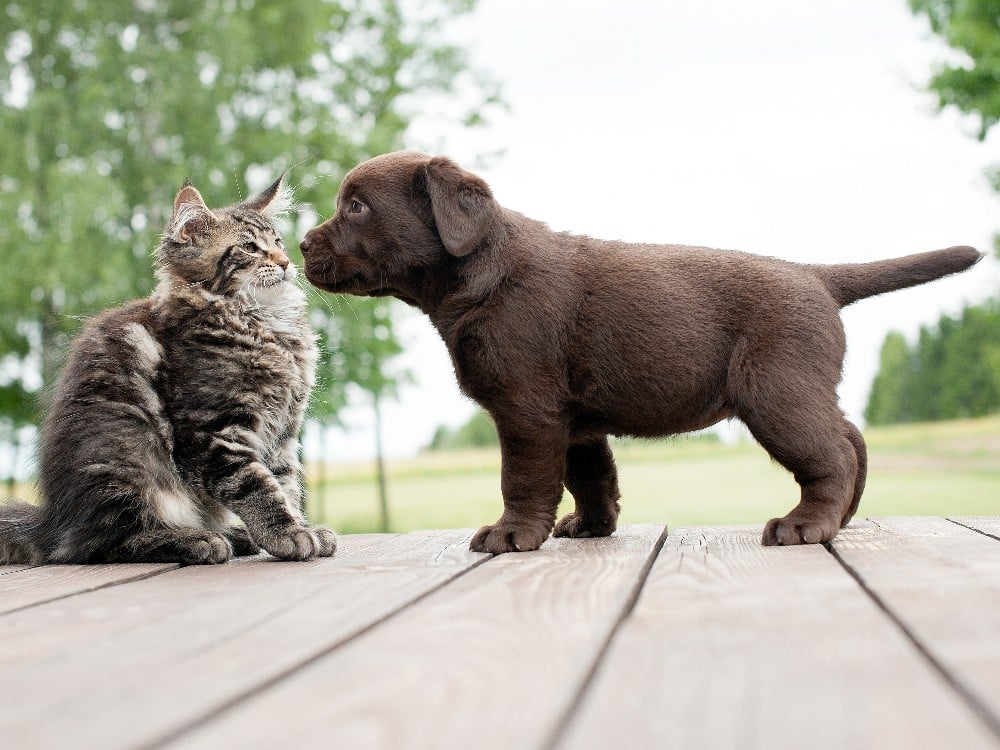Cats and dogs don’t have to be sworn enemies, and by properly introducing them, a cat and a dog can live in harmony. If your cat and/or dog have previously lived with others of the opposite species, you might be inclined to rush the relationship between the two. However, every situation is unique and it’s best to take it slow and follow the steps to ensure success.
Create a safe space for the cat
The first priority is safety, especially for the cat, regardless of who is the newcomer. In a separate room, create a safe, dog-free zone equipped with all the supplies your cat needs. For a kitten, use a large crate with enough room for a litter box and dishes for food and water. Prepare this cat haven before the new pet comes home so the resident dog or cat to get used to this new arrangement.
Prepare for dog and cat introductions
Keep your pets separated by confining the cat to the spare room for the first few days so the new pet can adjust to its new home and human family members. Introduce each pet to the other’s scent by exchanging bedding and allowing both of them to thoroughly sniff it over. While the dog is outside, allow the cat to explore the dog’s space.
The first meeting
Before proceeding to the next stage, make sure your dog gets plenty of exercise (a run, a long walk, a round of fetch, etc.) so they aren’t entering the situation full of energy. Keep the kitten in its crate, or for an older cat, create a barrier with baby gates. Before the first meeting, leash the dog to curb any instincts to chase. Open the door to the spare room and allow your pets to see each other at a distance, with the barrier of the gate or crate between them.
Watch your dog’s and cat’s body language
Pay attention to the body language of each pet—ideally, both should be loose and relaxed. Praise your dog with a treat and a soothing voice if he remains calm. Dogs with a strong prey drive will be stiff and on high alert and may start barking or whining. If your dog locks into a stare or is excessively focused on the cat, distract him with a treat or take him away and close the door.
Don’t force your cat to approach the gate—just allow her to move toward the dog on her own time. If she is hissing, attempting to scratch, or trying to flee, separate the pets and try again later. Keep these meetings short at first and repeat them regularly until both pets become more comfortable with the presence of the other.
A budding friendship between your dog and cat
When both pets seem comfortable and relaxed in the presence of the other, you can allow them to meet and sniff each other through the barrier. Keep the dog leashed to be safe. After these interactions have been consistently going well, your pets can be around each other without a barrier while the dog is still leashed, then eventually, off leash. Always provide supervision when your pets are around each other without barriers, otherwise, keep them separated until they have developed a solid relationship and you can trust both pets with the other.
Tips
- This may be your dog’s first time living with a cat, so make sure that the litter box and cat food are inaccessible to your dog.
- As the mediator, it’s important for you to stay relaxed and patient, especially since pets can pick up on your stress or nervousness.
- Don’t rush the process and understand that it may take days or weeks for both pets to adjust to this new dynamic.
Extra help for introducing dogs and cats
For particularly challenging situations, consider the following options to help a nervous pet.
- Calming wraps such as a Thundershirt
- Feliway pheromone diffuser
- Calming nutritional supplements– use as advised by your veterinarian
- Contact an animal behaviorist for assistance







